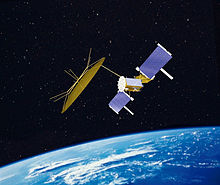- Mobile User Objective System
-
Mobile User Objective System (MUOS) ist ein Satellitenkommunikationssystem der US Navy, das ab 2011 das bestehende UFO-System ablösen soll. Das MUOS-System soll die Datenübertragungskapazität im Vergleich zu seinem Vorgängersystem verzehnfachen.
Insgesamt sollen fünf dieser Satelliten beschafft werden. Zwei sind bereits bestellt, für drei weitere bestehen Optionen. Der erste Satellit soll 2012 mit einer Atlas-V(511)-Rakete von der Cape Canaveral Air Force Station gestartet werden. Das Programm hatte sich von einem ursprünglich für 2008 geplanten Erststart immer weiter verzögert. Die Kosten für die ersten beiden Satelliten sowie die Bodenkontrolleinrichtungen betragen 2,1 Mrd. US-Dollar. Wenn die zusätzlichen Optionen für weitere drei Satelliten ausgeübt werden, beträgt das Auftragsvolumen 3,26 Mrd. US-Dollar.
Inhaltsverzeichnis
Aufbau der Satelliten
Die Satelliten basieren auf dem kommerziellen Satellitenbus A2100 von Lockheed Martin Space Systems. Sie besitzen eine 18,7 m große entfaltbare Hauptantenne und eine kleinere, ebenfalls entfaltbare Antenne, die beide von der Harris Corporation gebaut werden. Weitere Unterauftragnehmer sind Boeing, die eine UHF-Nutzlast liefern, um eine Kompatibilität zum älteren UFO-System herzustellen sowie General Dynamics und Ericsson für die Bodenkomponenten.
Die primäre Kommunikationsnutzlast arbeitet im Frequenzbereich von 300 MHz bis 3 GHz und ermöglicht den Truppeneinheiten, über Mobiltelefonartige Wege zu kommunizieren. Die MUOS-Satelliten ersetzen dabei die Basisstationen eines terrestrischen zellulären Netzwerks.
Starts
Für den ersten Start eines MUOS-Satelliten ist bereits ein Vertrag für eine Atlas V abgeschlossen worden. Es ist wahrscheinlich, dass die weiteren Satelliten ebenfalls mit diesem Raketenmodell gestartet werden. Alle Starts werden von der Cape Canaveral AFS erfolgen.
Satellit Startdatum Rakete Bemerkung MUOS 1 2012[1] Atlas V(551) geplant MUOS 2 ?[1] geplant MUOS 3 ? Option MUOS 4 ? Option MUOS 5 ? Option Einzelnachweise
Weblinks
- Globalsecurity.org: Mobile User Objective System (MUOS) (englisch)
- Gunter's Space Page: MUOS 1, 2, 3, 4, 5 (englisch)
- Todd Neff, Ben Iannotta: Comm crisis - Delay in U.S. Navy satellite program sparks reviews and contingency planning. Defense News, 1. August 2009, abgerufen am 9. April 2010 (englisch).
- MacMullan et al: Geosynchronous Satellites for MUOS (englisch, PDF)
- Sadowsky: The MUOS-WCDMA Air Interface (englisch, PDF)
Kategorien:- Militärischer Satellit
- Kommunikationssatellit
- Militärische Raumfahrt der Vereinigten Staaten
Wikimedia Foundation.


